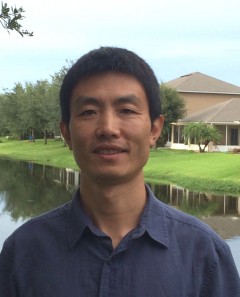
Liao, Yi

Yi Liao
Professor | College of Engineering and Science: Chemistry and Chemical Engineering
Contact Information
Expertise
Educational Background
Ph.D. Organic Chemistry, University of Massachusetts, Amherst, 2001
B.S. in Chemistry, Nankai University, Tianjin, China, 1995
Professional Experience
2018-present Professor, Florida Institute of Technology, Melbourne FL.
2013-2018 Associate Professor, Florida Institute of Technology, Melbourne FL.
2006-2013 Assistant Professor, University of Central Florida, Orlando, FL.
2002-2006 Postdoc University of Washington, Seattle, WA.
2001-2002 Postdoc University of Utah, Salt Lake City, UT.
1999 Research Associate at Targacept company, Winston Salem, NC.
Current Courses
CHM 1101 General Chemistry 1
CHM 5550 Polymer Chemistry
CHM 5305 Electronic and Optical Materials (Special Topics in Analytical Chemistry)
Selected Publications
Photoproton chemistry:
- Liao, Y. Reversible photo control of proton chemistry, Phys. Chem. Chem. Phys. (2022), 24(7), 4116-4124.
- Liao, Y. Design and Applications of Metastable-State Photoacids. Acc. Chem. Res. (2017), 50, 1956-1964.
- Elgattar A, Abeyrathna N, Liao Y. Localized pH Pulses in PBS Buffer Repeatedly Induced by Visible Light. J. Phys. Chem. B, (2019) 123, 648-654.
- Abeyrathna, N.; Liao, Y., A reversible photoacid functioning in PBS buffer under visible light. J. Am. Chem. Soc. (2015), 137, 11282-11284.
- Shi, Z.; Peng, P.; Strohecker, D.; Liao, Y., A long-lived photoacid based upon a photochromic reaction. J Am. Chem. Soc. (2011) 133(37), 14699–14703.
Carbon monoxide releasing materials:
- Abeyrathna, N.; Kenyatta W.; Bashur, C.; Liao, Y. Nonmetallic carbon monoxide releasing molecules (CORMs). Org. Bio. Mol. Chem. (2017) 15, 8692-8699.
- Alghazwat, O; Talebzadeh, S; Oyer, J; Copik, A; Liao, Y, Ultrasound responsive carbon monoxide releasing micelle, Ultrasonics Sonochemistry (2021), 72, 105427.
- Peng, P.; Wang, C.; Shi, Z.; Johns, V. K.; Ma, L.; Oyer, J.; Copik, A.; Igarashi, R.; Liao, Y., Visible-light activatable organic CO-releasing molecules (PhotoCORMs) that simultaneously generate fluorophores. Org. Biomol. Chem. (2013) 11, 6671-6674.
Other:
- Chen, H.-B..; Zhao, Y.; Liao, Y., Aldehyde-alkyne-amine (A3) coupling catalyzed by a highly efficient dicopper complex. RSC Adv. (2015), 5, 37737-37741.
- Johns, V. K.; Shi, Z.; Dang, W.; McInnis, M. D.; Weng, Y.; Liao, Y. Photo retro-Diels-Alder reactions. J Phys. Chem. A. (2011), 115(28), 8093–8099.
Research
Current research focuses on photoproton chemistry. Proton chemistry is the chemistry that is induced by proton transfer, which is one of the most fundamental processes in nature. Most of proton transfer processes are driven by a high concentration of proton, and many chemical, material, and biological processes are sensitive to proton concentration, from acid-catalyzed reactions to the activities of many enzymes. Using light to modulate proton concentration and proton transfer will allow us conduct these proton chemistry with remote, temporal and spatial control. Metastable-state photoacid, which was discovered by our group, is the only type of molecule that can reversibly produce a large proton concentration (pH change) under photoirradiation. Using metastable-state photoacids, one can not only initiate proton chemistry with light, but the process can also be stopped and/or reversed by turning off the light or using a different stimulus, e.g. heating or light with a different wavelength. This type of photoacid can be generally designed by coupling a reversible photoreaction with a proton dissociation process. We design and synthesize different types of metastable-state photoacids and the materials containing them, study the mechanisms of their photoreactions, and demonstrate their applications in chemical, material, enery, and biomedical areas. This type of photoacid has also been used by many other groups for different applications.
Our group is also working on carbon monoxide (CO) releasing materials (CORM). While carbon monoxide is well known as a toxic gas, it is actually a naturally-occurring vasodilator. Preclinical studies have shown that a controlled dose of carbon monoxide can reduce cardiovascular disorders and protect neuro cells. PhotoCORM, which releases CO upon irradiation allows remote, temporal and spatial control of CO release and thus has been intensively studied in recent years. Most CORMs including photoCORMs are metal carbonyls, which present a long-term health concern due to potential toxicity of the heavy metals. Our group reported the first organic photoCORMs in 2013. These photoCORMs can be activated by visible light, have potentially low toxicity, allow the delivery of carbon monoxide to be monitored by fluorescence imaging techniques, and thus are useful tools for the study of the biological functions of CO. Recently we developed the first ultrasound responsive CORM by incorporating a metal carbonyl in to an ultrasound responsive polymer nanoparticle.
Research & Project Interests
Research of Liao’s group has been focused on discovering new photochemical processes, designing and synthesizing molecules and polymers based on these photochemical processes, and demonstrating their potentials in material, enery, catalytic and biomedical applications. In addition, we also conduct research on electric and optic materials. Our group closely works with material engineers, biochemists and physical chemists to make our research fruitful.

 Give to Florida Tech
Give to Florida Tech